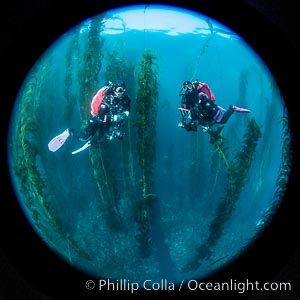
SCUBA divers, San Clemente Island.
Species: Giant kelp, Macrocystis pyrifera
Location: San Clemente Island, California
Image ID: 38507
Species: Giant kelp, Macrocystis pyrifera
Location: San Clemente Island, California
Image ID: 38507
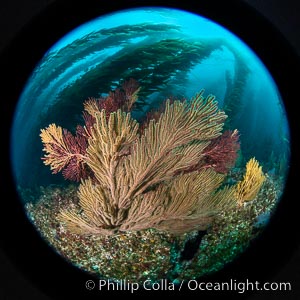
Garibaldi and California golden gorgonian on underwater rocky reef, San Clemente Island. The golden gorgonian is a filter-feeding temperate colonial species that lives on the rocky bottom at depths between 50 to 200 feet deep. Each individual polyp is a distinct animal, together they secrete calcium that forms the structure of the colony. Gorgonians are oriented at right angles to prevailing water currents to capture plankton drifting by.
Species: California golden gorgonian, Giant kelp, Muricea californica, Macrocystis pyrifera
Location: San Clemente Island, California
Image ID: 38509
Species: California golden gorgonian, Giant kelp, Muricea californica, Macrocystis pyrifera
Location: San Clemente Island, California
Image ID: 38509
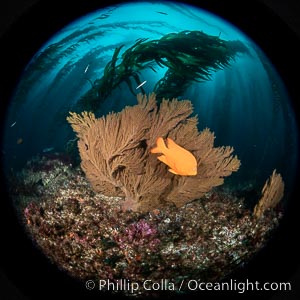
Garibaldi and California golden gorgonian on underwater rocky reef, San Clemente Island. The golden gorgonian is a filter-feeding temperate colonial species that lives on the rocky bottom at depths between 50 to 200 feet deep. Each individual polyp is a distinct animal, together they secrete calcium that forms the structure of the colony. Gorgonians are oriented at right angles to prevailing water currents to capture plankton drifting by.
Species: California golden gorgonian, Giant kelp, Garibaldi, Muricea californica, Macrocystis pyrifera, Hypsypops rubicundus
Location: San Clemente Island, California
Image ID: 38510
Species: California golden gorgonian, Giant kelp, Garibaldi, Muricea californica, Macrocystis pyrifera, Hypsypops rubicundus
Location: San Clemente Island, California
Image ID: 38510
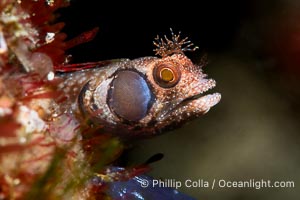
Acanthemblemaria crockeri, Brown-cheek barnacle-blenny, Islas San Lorenzo, Sea of Cortez.
Species: Brown-cheek barnacle-blenny, Acanthemblemaria crockeri
Location: Islas San Lorenzo, Baja California, Mexico
Image ID: 40444
Species: Brown-cheek barnacle-blenny, Acanthemblemaria crockeri
Location: Islas San Lorenzo, Baja California, Mexico
Image ID: 40444
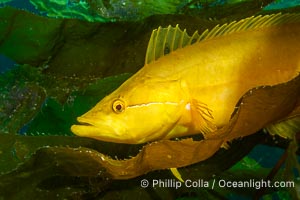
Giant kelpfish in underwater kelp forest, Catalina Island.
Species: Giant kelpfish, Heterostichus rostratus
Location: Catalina Island, California
Image ID: 40523
Species: Giant kelpfish, Heterostichus rostratus
Location: Catalina Island, California
Image ID: 40523
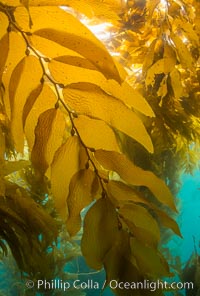
Giant kelp frond showing pneumatocysts. Small gas bladders -- pneumatocysts -- connect the kelp's stipes ("stems") to its blades ("leaves"). These bladders help elevate the kelp plant from the bottom, towards sunlight and the water's surface.
Species: Giant kelp, Macrocystis pyrifera
Location: Catalina Island, California
Image ID: 33439
Species: Giant kelp, Macrocystis pyrifera
Location: Catalina Island, California
Image ID: 33439
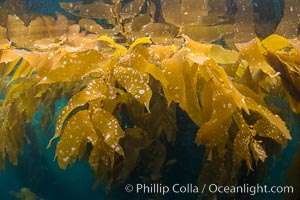
Giant kelp frond showing pneumatocysts. Small gas bladders -- pneumatocysts -- connect the kelp's stipes ("stems") to its blades ("leaves"). These bladders help elevate the kelp plant from the bottom, towards sunlight and the water's surface.
Species: Giant kelp, Macrocystis pyrifera
Location: Catalina Island, California
Image ID: 33440
Species: Giant kelp, Macrocystis pyrifera
Location: Catalina Island, California
Image ID: 33440
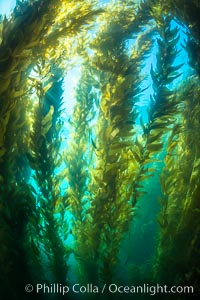
Sunlight streams through giant kelp forest. Giant kelp, the fastest growing plant on Earth, reaches from the rocky reef to the ocean's surface like a submarine forest.
Species: Giant kelp, Macrocystis pyrifera
Location: Catalina Island, California
Image ID: 33441
Species: Giant kelp, Macrocystis pyrifera
Location: Catalina Island, California
Image ID: 33441
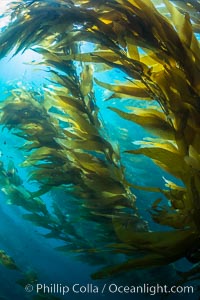
Sunlight streams through giant kelp forest. Giant kelp, the fastest growing plant on Earth, reaches from the rocky reef to the ocean's surface like a submarine forest.
Species: Giant kelp, Macrocystis pyrifera
Location: Catalina Island, California
Image ID: 33442
Species: Giant kelp, Macrocystis pyrifera
Location: Catalina Island, California
Image ID: 33442
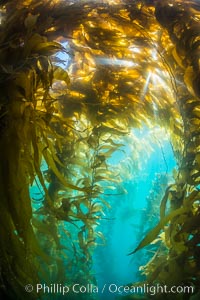
Sunlight streams through giant kelp forest. Giant kelp, the fastest growing plant on Earth, reaches from the rocky reef to the ocean's surface like a submarine forest.
Species: Giant kelp, Macrocystis pyrifera
Location: Catalina Island, California
Image ID: 33443
Species: Giant kelp, Macrocystis pyrifera
Location: Catalina Island, California
Image ID: 33443
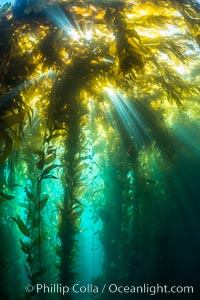
Sunlight streams through giant kelp forest. Giant kelp, the fastest growing plant on Earth, reaches from the rocky reef to the ocean's surface like a submarine forest.
Species: Giant kelp, Macrocystis pyrifera
Location: Catalina Island, California
Image ID: 33444
Species: Giant kelp, Macrocystis pyrifera
Location: Catalina Island, California
Image ID: 33444
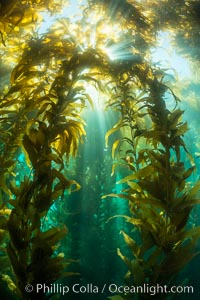
Sunlight streams through giant kelp forest. Giant kelp, the fastest growing plant on Earth, reaches from the rocky reef to the ocean's surface like a submarine forest.
Species: Giant kelp, Macrocystis pyrifera
Location: Catalina Island, California
Image ID: 33445
Species: Giant kelp, Macrocystis pyrifera
Location: Catalina Island, California
Image ID: 33445
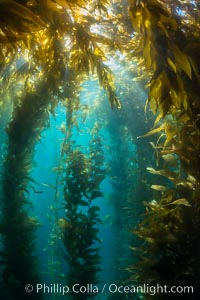
Sunlight streams through giant kelp forest. Giant kelp, the fastest growing plant on Earth, reaches from the rocky reef to the ocean's surface like a submarine forest.
Species: Giant kelp, Macrocystis pyrifera
Location: Catalina Island, California
Image ID: 33446
Species: Giant kelp, Macrocystis pyrifera
Location: Catalina Island, California
Image ID: 33446
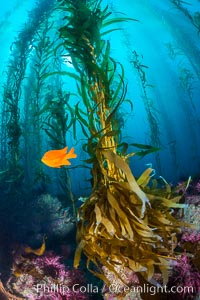
Kelp holdfast attaches the plant to the rocky reef on the oceans bottom. Kelp blades are visible above the holdfast, swaying in the current.
Location: Catalina Island, California
Image ID: 34212
Location: Catalina Island, California
Image ID: 34212
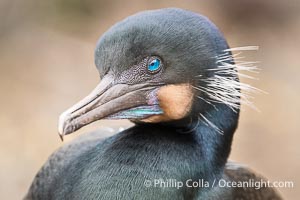
Brandt's Cormorant Portrait with Breeding Plumage, with blue throat and white feathers on each side of the head.
Species: Brandt's Cormorant, Phalacrocorax penicillatus
Location: La Jolla, California
Image ID: 40004
Species: Brandt's Cormorant, Phalacrocorax penicillatus
Location: La Jolla, California
Image ID: 40004
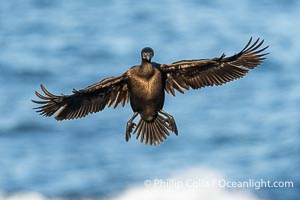
Brandt's Cormorant Spreading Wings to Land on sea cliffs overlooking the Pacific Ocean.
Species: Brandt's cormorant, Phalacrocorax penicillatus
Location: La Jolla, California
Image ID: 40084
Species: Brandt's cormorant, Phalacrocorax penicillatus
Location: La Jolla, California
Image ID: 40084
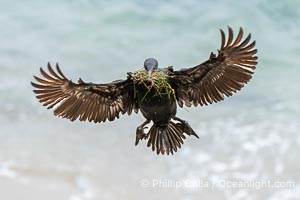
Brandt's Cormorant Flying Carrying Nesting Material, a clump of seaweed (marine algae) and surf grass, La Jolla.
Location: La Jolla, California
Image ID: 40812
Location: La Jolla, California
Image ID: 40812
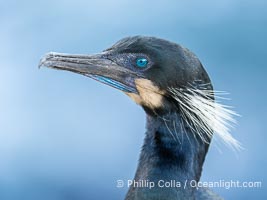
Brandt's Cormorant Portrait with Breeding Plumage, with blue throat and white feathers on each side of the head.
Location: La Jolla, California
Image ID: 40816
Location: La Jolla, California
Image ID: 40816
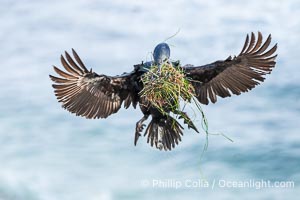
Brandt's Cormorant in flight carrying surfgrass for nest building, ocean background.
Species: Brandt's Cormorant, Phalacrocorax penicillatus
Location: La Jolla, California
Image ID: 40872
Species: Brandt's Cormorant, Phalacrocorax penicillatus
Location: La Jolla, California
Image ID: 40872
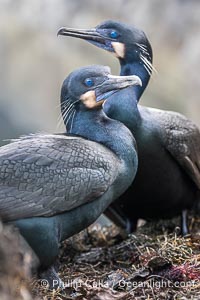
Nesting Pair of Brandt's Cormorants, on La Jolla Cliffs.
Species: Brandt's cormorant, Phalacrocorax penicillatus
Location: La Jolla, California
Image ID: 40881
Species: Brandt's cormorant, Phalacrocorax penicillatus
Location: La Jolla, California
Image ID: 40881
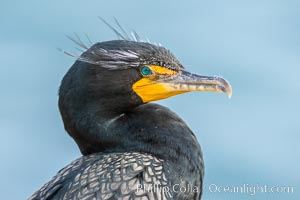
Double-crested cormorant in breeding plumage showing crest feathers on head. La Jolla, California, USA.
Species: Double-crested cormorant, Phalacrocorax auritus
Location: La Jolla, California
Image ID: 36769
Species: Double-crested cormorant, Phalacrocorax auritus
Location: La Jolla, California
Image ID: 36769
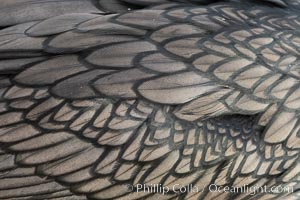
Double-crested cormorant feather detail, La Jolla, California, USA.
Species: Double-crested cormorant, Phalacrocorax auritus
Location: La Jolla, California
Image ID: 36770
Species: Double-crested cormorant, Phalacrocorax auritus
Location: La Jolla, California
Image ID: 36770
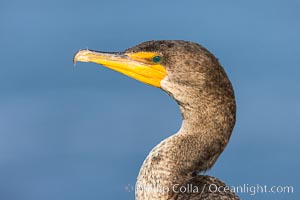
Double-crested cormorant, La Jolla, California, USA.
Species: Double-crested cormorant, Phalacrocorax auritus
Location: La Jolla, California
Image ID: 36774
Species: Double-crested cormorant, Phalacrocorax auritus
Location: La Jolla, California
Image ID: 36774
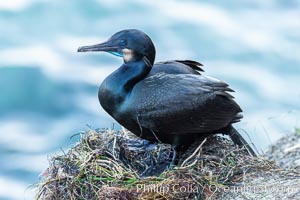
Brandt's Cormorant on the nest, nesting material composed of kelp and sea weed, La Jolla.
Species: Brandt's cormorant, Phalacrocorax penicillatus
Image ID: 36793
Species: Brandt's cormorant, Phalacrocorax penicillatus
Image ID: 36793
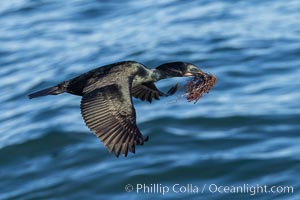
Brandt's Cormorant Flying with Nesting Material, a clump of seaweed (marine algae), La Jolla.
Species: Brandt's cormorant, Phalacrocorax penicillatus
Location: La Jolla, California
Image ID: 36837
Species: Brandt's cormorant, Phalacrocorax penicillatus
Location: La Jolla, California
Image ID: 36837

Double-crested cormorant nuptial crests, tufts of feathers on each side of the head, plumage associated with courtship and mating.
Species: Double-crested cormorant, Phalacrocorax auritus
Location: La Jolla, California
Image ID: 36847
Species: Double-crested cormorant, Phalacrocorax auritus
Location: La Jolla, California
Image ID: 36847
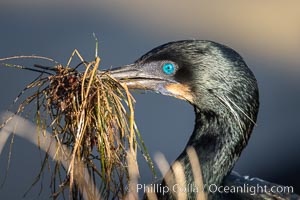
Brandt's Cormorant carrying nesting material in its beak.
Species: Brandt's cormorant, Phalacrocorax penicillatus
Location: La Jolla, California
Image ID: 36870
Species: Brandt's cormorant, Phalacrocorax penicillatus
Location: La Jolla, California
Image ID: 36870

Brandt's Cormorant portrait.
Species: Brandt's cormorant, Phalacrocorax penicillatus
Location: La Jolla, California
Image ID: 36875
Species: Brandt's cormorant, Phalacrocorax penicillatus
Location: La Jolla, California
Image ID: 36875
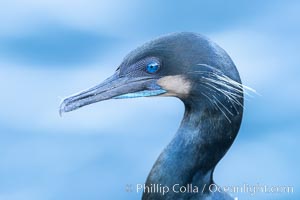
Brandt's Cormorant portrait.
Species: Brandt's Cormorant, Phalacrocorax penicillatus
Location: La Jolla, California
Image ID: 37596
Species: Brandt's Cormorant, Phalacrocorax penicillatus
Location: La Jolla, California
Image ID: 37596
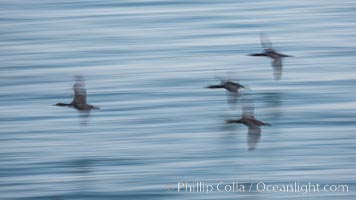
Cormorants in flight, wings blurred by time exposure.
Species: Double-crested cormorant, Phalacrocorax auritus
Location: La Jolla, California
Image ID: 30163
Species: Double-crested cormorant, Phalacrocorax auritus
Location: La Jolla, California
Image ID: 30163